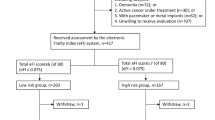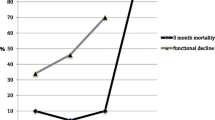Abstract
Objectives
Frail older adults are at an increased risk for adverse outcomes after an Emergency Department (ED) visit. Comprehensive geriatric assessment (CGA) has been proposed to screen for frailty in the ED, but it is difficult to carry out. We tested whether a CGA-based approach using the Identification of Seniors At Risk (ISAR) screening tool was associated with the brief deficit accumulation index (DAI) of frailty.
Design
Prospective observational study.
Setting
Two urban EDs in Italy.
Participants
A cohort of 200 elderly (≥65 years) ED patients.
Measurements
Identifiers, triage, clinical and social data along with the administration of ISAR. CGA was performed using: Charlson Index, Short Portable Mental Status Questionnaire and Katz’s ADL. Follow-up data at 30 and 180 days included: mortality, ED revisit, hospital admission, and.functional decline. Frailty was defined according to a brief DAI. Logistic regression evaluated the consistency of the frailty definition; ROC curves evaluated ISAR ability in identifying frailty.
Results
Frailty was present in 117 (58.5%) subjects and predicted ED revisit and frequent ED return, hospitalization and 6-month mortality. ISAR had an AUC of 0.92 (95%CI 0.88–0.96, p<0.0001) in identifying frail elders in the ED and using a cut-off of 2 showed 94% sensitivity and 63% specificity.
Conclusion
ISAR is a useful screening tool for frailty and identifies elderly patients at risk of adverse outcomes after an ED visit. ISAR can also be used to select high-risk patients more likely to benefit from a geriatric approach or intervention, independently of admission or discharge.
Similar content being viewed by others
References
Rockwood K, Mitniski A, Song X et al. Long-term risks of death and institutionalization of elderly people in relation to deficit accumulation at age 70. J Am Geriatr Soc 2006; 54:975–979
Fried LP, Tangen CM, Walston J, et al. Cardiovascular Health Study Collaborative Research Group. Frailty in older adults: Evidence for a phenotype. J Gerontol A Biol Sci Med Sci 2001; 56:1–11
Hogan DB, MacKnight C, Bergman H; Steering Committee Canadian Initiative on Frailty and Aging. Models, definitions, and criteria of frailty. Aging Clin Exp Res 2003; 15(S3):l–29
Hastings SN, Purser JL. Johnson KS, Sloane RJ. Whitson HE. Frailty predicts some but not all adverse outcomes in older adults discharged from the Emergency Department. J Am Geriatr Soc 2008; 56:1651–1657
Roberts DC, McKay MP, Shaffer A. Increasing rates of emergency department visits for elderly patients in the United States, 1993 to 2003. Ann Emerg Med 2008; 51:769–774
Salvi F, Morichi V. Grilli A et al. The elderly in the Emergency Department: a critical review of problems and solutions. Intern Emerg Med 2007; 2:292–301
Aminzadeh F, Dalziel WB. Older adults in the Emergency Department: a systematic review of pattern of use, adverse outcomes, and effectiveness of interventions. Ann Emerg Med 2002; 39:238–247
George G, Jell C. Todd BS. Effect of population ageing on emergency department speed and efficiency: a historical perspective from a district general hospital in the UK. Emerg Med J 2006; 23:379–383
Friedmann PD, Jin L, Karrison TG et al. Early revisit, hospitalization, or death among older persons discharged from the ED. Am J Emerg Med 2001; 19:125–129
McCusker J, Cardin S, Bellavance F et al. Return to the emergency department among elders; patterns and predictors. Acad Emerg Med 2000; 7:249–259
Caplan GA, Brown A, Croker WD et al. Risk of admission within 4 weeks of discharge of elderly patients from the emergency department—the DEED study. Age Ageing 1998; 27:697–702
McCusker J, Bellavance F, Cardin S et al. Prediction of hospital utilization among elderly patients during the 6 months after an emergency department visit. Ann Emerg Med 2000; 36:438–445
McCusker J, Bellavance F, Cardin S et al. Detection of older people at increased risk of adverse health outcomes after an emergency visit: the ISAR screening tool. J Am Geriatr Soc 1999; 47:1229–1237
Dendukuri N, McCusker J, Belzile E. The Identification of Seniors At Risk screening tool: further evidence of concurrent and predictive validity. J Am Geriatr Soc 2004; 52:290–296
Salvi F, Morichi V, Grilli A, et al. Predictive validity of the Identification of Seniors At Risk (ISAR) screening tool in elderly patients presenting to two Italian Emergency Departments. Aging Clin Exp Res 2009; 21:69–75
Charlson ME, Pompei P, Ales KL et al. A new method of classifying prognostic comorbidity in longitudinal studies: development and validation. J Chronic Dis 1987; 40:373–383
Murray SB, Bates DW, Ngo L et al. Charlson Index is associated with one-year mortality in emergency department patients with suspected infection. Acad Emerg Med 2006; 13:530–536
Pfeiffer E. Short Portable Mental Status Questionnaire for the assessment of organic brain deficit in elderly patients. J Am Geriatr Soc 1975; 23:433–441
Kalz S, Ford AB, Moskowitz RW et al. Studies of illness in the aged. The index of ADL: a standardized measure of biological and psychological function. JAMA 1963; 185:914–921
Rockwood K, Stadnyk K, MacKnight C, et al. A brief clinical instrument to classify frailty in elderly people. Lancet 1999; 353:205–206
Hwang U, Morrison RS. The geriatric emergency department. J Am Geriatr Soc 2007;55:1873–1876
McCusker J, Verdon J. Do geriatric interventions reduce emergency department visits? A systematic review. J Gerontol A Biol Sci Med Sci 2006; 61A:53–62
McCusker J, Jacobs P. Dendukuri N et al. Cost-effectiveness of a brief 2-stage emergency department intervention for high risk elders: results of a quasi-randomized Controlled trial. Ann Emerg Med 2003; 41:45–56
McCusker J, Verdon J, Tousignant P et al (2001) Rapid emergency department intervention for elders reduces risk of functional decline: results of a multi-center randomized trial. J Am Geriatr Soc 49:1272–1281
Moons P, De Ridder K, Geyskens K et al. Screening for risk of readmission of patients aged 65 years and above after the discharge from the emergency department: predictive value of four instruments. Eur J Emerg Med 2007; 14:315–23
Lee JS, Schwindt G, LLangevin M. et al. Validation of the triage risk stratification tool to identify older persons at risk for hospital admission and returning to the emergency department. J Am Geriatr Soc 2008; 56:2112–2117
Fan J, Worster A, Fernandes CMB. Predictive validity of the Triage Risk Screening Tool for elderly patients in a Canadian emergency department. Am J Emerg Med 2006;24:540–544
Di Bari M, Balzi D. Roberts AT. et al. Prognostic stratification of older persons based on simple administrative data: development and validation of the “Silver Code”, to be used in emergency department triage. J Gerontol A Biol Sci Med Sci 2010;65:159–164
Salvi F, Morichi V, Dessì-Fulgheri P. The “Silver Code” and the frail elder in the Emergency Department. J Gerontol A Biol Sci Med Sci 2010; 65:165
Salvi F, Morichi V, Grilli A. et al. A geriatric emergency service for acutely ill elderly patients: pattern of use and comparison with a conventional emergency department in Italy. J Am Geriatr Soc 2008; 56:2131–2138
La Mantia MA, Platts-Mills TF, Biese K, et al. Predicting hospital admission and returns to Emergency Departments for elderly patients. Acad Emerg Med 2010; 17:252–259
Hastings SN, Whitson HE, Purser JL, Sloane RJ, Johnson KS. Emergency Department discharge diagnosis and adverse outcomes in older adults. J Am Geriatr Soc 2009; 57:1856–1861
Jencks SF, Williams MV, Coleman EA. Rehospitalizations among patients in the Medicare fee-for-service program. N Engl J Med 2009; 360:1418–1428
Kiely DK, Cupples LA, Lipsitz LA. Validation and comparison of two frailty indexes: the MOBILIZE Boston Study. J Am Geriatr Soc 2009; 57:1532–1539
Boyd CM, Xue QL, Simpson CF, Guralnik JM, Fried LP. Frailty, hospitalization, and progression of disability in a cohort of disabled older women. Am J Med 2005; 118:1225–1231
Rockwood K, Andrew M, Mitnitski A. A comparison of two approaches to measuring frailty in elderly people. J Gerontol A Biol Sci Med Sci 2007; 62:738–743
Kulminski AM, Ukraintseva SV, Kulminskaya IV, et al. Cumulative deficits better characterize susceptibility to death in elderly people than phenotypic frailty: lessons from the Cardiovascular Health Study. J Am Geriatr Soc 2008; 56:898–903
Author information
Authors and Affiliations
Corresponding author
Rights and permissions
About this article
Cite this article
Salvi, F., Morichi, V., Grilli, A. et al. Screening for frailty in elderly emergency department patients by using the Identification of Seniors At Risk (ISAR). J Nutr Health Aging 16, 313–318 (2012). https://doi.org/10.1007/s12603-011-0155-9
Received:
Accepted:
Published:
Issue Date:
DOI: https://doi.org/10.1007/s12603-011-0155-9




